I started my undergraduate studies in economics in the late 1970s after starting out as…
The waves of recession
Today I have been working on part of a new book I am writing on the pathology of recessions. I have written a lot about this in the past and my last book was about this topic. But you can never say it enough – recessions impose huge social costs on the most disadvantaged members of our society and it is the responsibility of national governments to do every they can to avoid them. The neo-liberal onslaught on public policy has seen governments all around the world abandon this responsibility with obvious (ugly) consequences. Anyway, here is a way of thinking about all of this. It is not a happy story.
Yesterday, the UK Office of National Statistics released the latest labour market data for Britain which showed that nearly one million young people are now unemployed in Britain (700,000 18-24-year-olds and 206,000 16-17-year-olds). Only 28.6 per cent of 16-17 year olds have work (down from 34 per cent 12 months ago). That means over 1 in 6 young persons in Britain are now jobless.
The Princes Trust, which is a do-gooder arm of the parasitic British monarchy (oops, our monarchy too!) said that “a young person in Britain lost a job almost every minute between March and May and alone.”
More generally, the Guardian newspaper reported that:
Unemployment in Britain jumped by 220,000 in the three months to June to 2.435 million … the highest level since 1995 … the jobless rate was now 7.8% of the workforce. The figures also showed a huge 271,000 drop in the number of people in work – the biggest fall since records began in 1971.
There was a rise of more than 50,000 in the number of the under-25s without work to a total of 928,000, fuelling fears of a “lost generation” of jobless.
A report in The Times yesterday said that the recession was now impacting on home life. The reporter said that “Britain faces a surge in drug addiction, alcoholism and domestic violence as the second wave of the recession and rising unemployment take a grip, the leading public sector watchdog warns today.”
The article was in fact commenting on the recently released UK Audit Commission report – When it comes to the crunch, which analyses how local government in the UK is coping with the massive recession that is impacting on their communities. It is essential reading in my view.
The Audit Commission found that local government (councils) are not providing the necessary support for communities which are facing:
… increasing social problems including domestic violence, alcoholism, drug addiction and young people unable to find jobs. Councils may also have to deal with more fly-tipping, abandoned cars and stray dogs.
In the Appendix of the Report, they produced a diagram which they called the “three waves of a recession”. They define these waves on Page 13 as:
Wave 1: Economic. A relatively short period where economic output declines; firms fail or reduce staff numbers; unemployment rises quickly; and real incomes fall.
Wave 2: Social. A longer period in which output growth returns, but job losses continue. Unemployment remains high, bringing with it increasing housing, health and domestic problems.
Wave 3: Unequal recovery. Recovery occurs when the economy is expanding and unemployment has passed its peak. Investment and economic development return, but not all areas
I reproduce the diagram here.
The graphic is very descriptive of what happens during a typical recession – no matter how deep the economic downturn is. The duration of the waves is a very important point. The contraction may be relatively short (Wave 1). But the detritus that it leaves as the country starts moving through Waves 2 then 3 is usually very signficant.
To get a feel for how this might translate into Australian experience I produced this graph which shows the course of quarterly GDP growth (blue line) in per cent and the level of unemployment (in 000s) since November 1989 – so the low-point unemployment rate quarter preceeding the 1991 recession. The green shaded areas depict Wave 1 and the grey areas the Wave 2 periods – although the separation of the waves is not as clean in reality as a literal reading of the the schematic produced by the UK Audit Commission would suggest.
The lesson is that recessions are very long-lived episodes that impact negatively on people for years after the factories are churning out output again.
I have done a lot of research in the past documenting the social costs of recessions and the madness by governments in allowing them to occur. More on this later in the blog.
Age-related waves of recession in Australia post 1991 recession
To translate the last aggregate graph into age-related profiles I produced the following graph. It might look a bit daunting but it actually is fairly easy to read. I deliberately made it larger than usual so that you could see the detail better. I didn’t put the Wave 1 and Wave 2 shading into to avoid confusion but you can easily work those phases out yourselves.
The lines are the age-related unemployment rates (15-19 year olds, 20-24, 25-34, 35-44, 45-54, 55-59, and 60-64 year olds) graphed from the low-point aggregate unemployment in the 1991 cycle (which occurred at November 1989) for another 40 quarters (10 years). The unemployment rates are expressed in index number form with the base quarter being 100 set at quarter 4 1989. So the lines show you how fast the unemployment rates rose and fell over the decade. The scale is on the left-hand axis.
The bar data (grey) is annual GDP growth over the same period (per cent per annum) for each quarter and the scale is on the right-hand axis. The average GDP growth rate for the entire decade was 3.3 per cent. The average GDP growth rate for the period that the aggregate unemployment rose (1989:4 to 1992:4) was 1.1 per cent per annum, whereas the average for the rest of the period as the aggregate unemployment rate fell was 4.3per cent per annum. So for three years, output growth was insufficient to absorb labour force and productivity growth and as a consequence the unemployment rate rose.
In thinking about the behaviour you have to be careful to take into account cohort effects – so the 15-19 years at the start of the recession were all by definition 20-24 year olds 5 years later (many before then). With long-term unemployment entrenched after 1 year, there was a lot of disadvantaged youths becoming chronically disadvantaged 20-somethings by the end of the 1990s.
The first thing to note is that only the 60-64 year old unemployment rate was lower after 10 years despite the latter years of above average growth for the decade.
The following table reports some salient details about the dynamics of the age-related unemployment rates over the drawn out recovery. For example, the teenage unemployment rate was still 30.5 per cent above its starting point (which was 14.2 per cent) and despite the years of economic growth didn’t return to its pre-1991 recession low-point until quarter 4, 2006 -just in time to start rising again some 14 months later.
Conclusion
The first problem with allowing a recession to occur and move into Wave 2 is that it is very difficult to get unemployment down very quickly using the market system. The following rule applies (with some approximation as cyclical effects modify participation and hours worked). On average, GDP growth every period has to be equal to labour force growth plus labour productivity growth if the unemployment rate is not to rise.
Labour productivity growth reduces the labour required to produce the given GDP while labour force growth adds to the number of jobs that have to be produced to absorb the new entrants. So for every quarter that GDP growth is below this sum, the unemployment rate rises.
Consider the following table which shows the annual GDP growth rate from 1986 to 2009, the annual Labour Force (LF) and Labour productivity (LP) growth rates for the same period. It also computes the Required GDP growth rate (to keep the unemployment rate from rising) = LF + LP. The GDP gap then is Required GDP growth – GDP growth, which if it is negative then actual GDP growth is strong enough to cut into unemployment – so the unemployment rate would be falling and vice versa.
The periods shown are five year intervals (so averages over those time spans). You can see that these broad averages still pick up considerable variation in the economy’s ability to grow fast enough to eat into unemployment. During the golden years (1960-1970) GDP growth was always sufficient due to active interventionist fiscal policy from a government committed to full employment. Since then this cannot be said.
Now once unemployment has risen in Waves 1 and 2 to very high levels, then a return to trend GDP growth will not be enough to absorb the new entrants, the growth in labour productivity and the pool of long-term unemployed that are present during Wave 3.
Say that the labour force is growing around 1.8 per cent (which is about average) and labour productivity is growing around 2.5 per cent (again not unrealistic over a long period). At high levels of employment, high productivity growth was definitely possible.
At any rate, under these assumptions, GDP growth has to be 4.3 per cent just to stop the unemployment rate from rising.
To put this in perspective, the consider the GDP growth rates depicted in the Table. For the golden years of full employment it averaged around 4.8 per cent per annum whereas over the last 9 years it has averaged less than 3 per cent per annum.
So even in the full employment period with budget deficits large enough to finance private saving desires without compromising output growth we only grew in the high 4’s on average every year.
In the last 9 years, with GDP growth averaging less than 3.0 per cent per annum, the only reason unemployment didn’t soar was because of the low productivity growth that accompanied the GDP growth. This was directly related to Government policies that dumbed the economy down – deregulation and a failure to support adequate skills development – it was the the “race to the bottom” growth phase!
So now do some sums. Assume we could achieve a 5 per cent growth average every year, which is not likely. Then if you enter Wave 2 with an unemployment rate of say 10 per cent (10.7 in 1992) then each year you would have to drive GDP growth by 4.3 per cent just to keep the unemployment rate from rising. So at 5 per cent per annum you would only reduce the unemployment rate by 0.7 per cent each year. It would thus take a decade to get down to 3 per cent.
While the unemployment rate is lower now the problem remains. Any rise in unemployment will take years to unwind. In the meantime the loss of that human potential is huge as are the costs imposed on the individuals made to bear the brunt of the failed government policy.
Now government can clearly use fiscal policy to increase the GDP growth rate whenever it wants. Clearly it becomes a problem trying to drive real GDP growth via nominal spending growth faster than the real capacity of the economy will permit. Yes, it is called inflation!
Further, the capacity losses that occur as a result of drawn out recessions reduce the potential GDP growth path into the future. This makes it harder again to get unemployment down without generating inflation.
So once you allow unemployment to rise sharply during Waves 1 and 2 of a recession, you face an inflation barrier if you try to drive GDP growth to levels necessary to quickly eat into the jobless pool.
It is a no-brainer that it is best to avoid Wave 2 from happening in the first place. That is one of the reasons I have always advocated strong public sector job creation. It is a powerful case for running a Job Guarantee, where the national government would employ anyone at a fixed wage who wanted to work.
It immediately stops the unemployment from rising and provides a basic buffer against poverty – which always rises during an unemployment-driven recession. While high paid workers would lose income even if a Job Guarantee was in place, the losses would be reduced. Further, the burden of unemployment falls on the low-skilled workers and the income losses then would be relatively small.
As a high quality automatic stabiliser, the Job Guarantee would more quickly dampen the downturn and provide a faster recovery path. It is almost unbelievable that national governments around the world which have sovereignty in their own currencies and therefore can easily employ all the labour that is not wanted by the non-government sector would allow that labour to remain idle – in increasing volumes.
Given the costs of recession, the fact that they allow unemployment to rise is one of the starkest examples of the failure of neo-liberalism to deliver high quality social outcomes.
And to repeat – within the context of the intergenerational debate – which is always focused on deficits and debts – the intergenerational disadvantages that arise from unemployment are one of the largest burdens we visit on our children. In the UK, 1 in 6 of them are now languishing idle while MPs cheat their allowances!
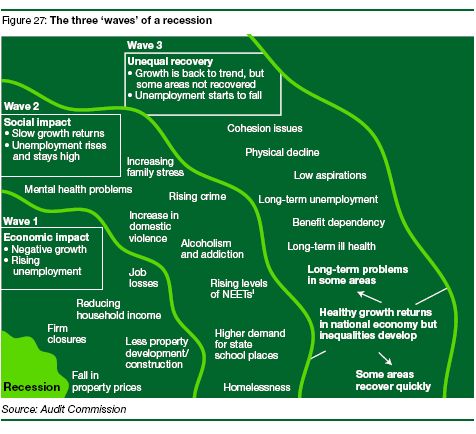
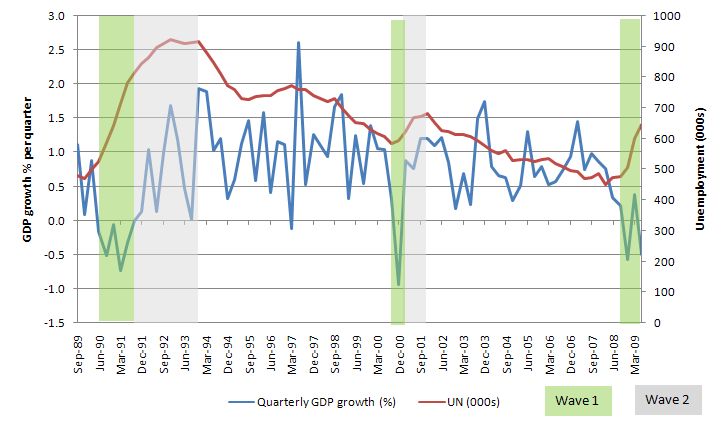
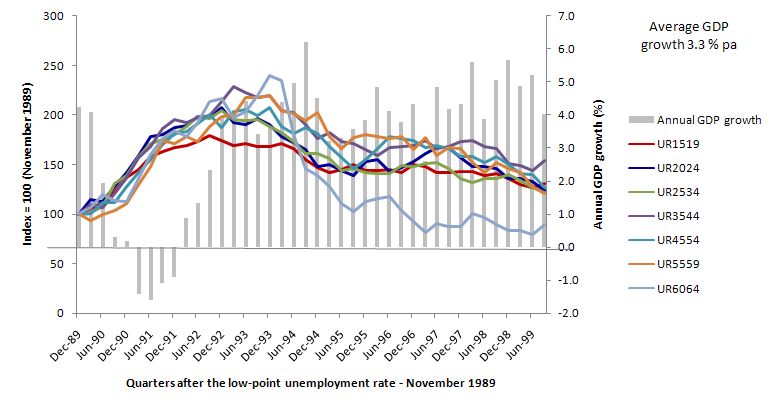
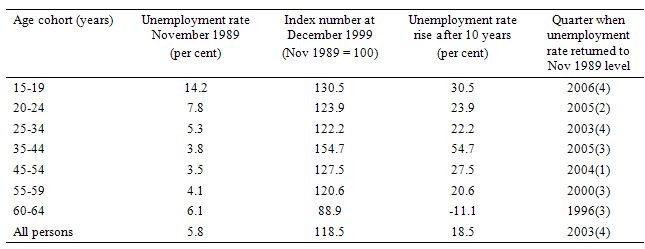
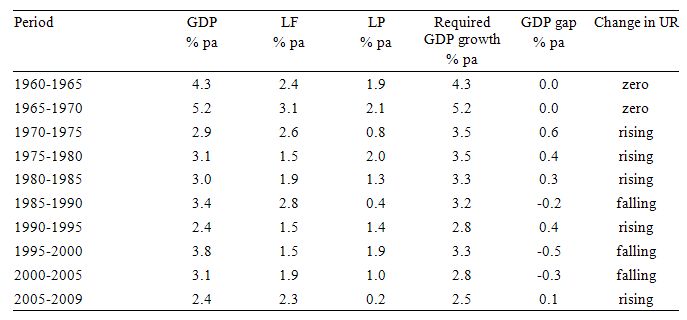
Dear Bill,
Anyone who is forced to participate in a program that is run by the government of the day, and designed by an academic who earns well over 200k per annum will be for all effective purposes financially, emotionally, and socially living in poverty.
Do not for a moment assume that you know what is best for other people because it only makes you part of the problem that already exists.
Bill you used to fight against governments forcing people to participate in events they neither endorsed or supported and yet now you want to coerce people into Jobs Guarentee positions that they may not otherwise choose.
By saying people have a choice you are simply saying it is your way or starve – gee that sounds so Howard / Coalition now doesn’t it ?
cheers Alan.
Dear Alan
1. Your assumption about my salary remains an assumption. It is also better not to conflate an idea with the personal circumstances of the proponent. That is always a dangerous strategy. It is always better not to personalise things like this.
2. The Job Guarantee if implemented according to my proposal, by construction, would not leave anyone living financially in poverty.
3. I never assume to know what is best for an individual. All the research points to unemployed people saying they prefer to work than remain unemployed. For what its worth, the choices are so bad, that the surveys even find people prefer overwhelmingly to participate in Work for the Dole than to be isolated in unemployment. I find that result disturbing but telling.
4. For my entire career, the orthodoxy has called me a rabid lefty and the left has called me a sell-out to capitalism. I am comfortable with that. But I adopted the view a long-time ago that I was not going to advocate the demise of capitalism and write about that from the confines of my secure job and comfortable ivory tower office or discuss it while sipping coffee at some inner-city location cafe in an environment where we have persistently high unemployment and rising underemployment and not do something about the latter. It is easy to talk about what will happen when the revolution comes but for the time being there is poverty and suffering amidst and the Job Guarantee aims squarely to attenuate the worst of that dysfunction while we work towards “the revolution”. Yes it is palliative care. Yes, it is not the long-term solution. Yes, it is a reflection of the poverty of the capitalist system.
But, given that, how can paying someone a proper living wage with job security (in a Job Guarantee) with additional benefits including, holiday and sick pay, superannuation, loadings for weekend and public holidays, choice of hours, and other social wage benefits – free dental and health care, etc – to do valuable community work – not a superior solution to using fiscal and monetary policy in such a way that the same person remains unemployed in poverty and isolation?
Unless one says all work is coercive. At which point I would agree but then conclude there is nothing further that is sensible that can be said other than to question that person’s commitment to reducing unemployment and the associated financial and social poverty that accompanies it.
One of my favourite songs is called The revolution was Postponed due to rain by the Brooklyn Funk Essentials. The lyrics are below. It captures my view of those who don’t want to do something now to even slightly improve things.
The Revolution Was Postponed Because Of Rain
David Allen
The underlying
immediate
political
socio-economic
and trigger mechanism causes
were all in place when
some nee-gro or the other got hungry
had to stop at the McDonalds
had to get on the line
with the new trainee cashier
“uhh, where’s the button for the fries?”
so we missed the bus
Then the leader couldn’t find his keys
didn’t want some poor ass moving
his brand new 20″ and VCR
out his living room on the shoulders.
It was too late when the locksmith came
Then our demo expert Willie Blew got arrested
came out with his head hanging under his hoody
“Didn’t know they started doing that
for jumping the turnstiles,” he said.
“How many times must we tell you-
don’t get caught.”
we voted against shootin’ him on the spot
In the winter we were all depressed
so we leaned our guns against the sofas
and listened instead to Tim Tim Tiree
singing about his dysfunctions:
Sometimes I wonder if ah’ll ever be free
free of the sins of my brutish daddee
Like the cheating, the stealing, the drinking, and the beating. . .
The weatherman said the 17th would be sunshine
and it wouldn’t be too hot-
Tim Tim Tiree doesn’t like sweatin’
but that night the weatherman came on crying
saying he didn’t control the weather
that God was real
that he’s lucky He, God, didn’t strike him, the weatherman, with lightening
for taking the credit sometimes
and that he, the weatherman, was in no way responsible
for the hurricane coming
and that we, the viewers, should
pray Jesus into our hearts
before it was too late
Superbowl Sunday was out
all the women wanted
to see the game
and the men were pissed
at their insensitivity
The 20th was supposed to be a definite
we looked for some Bastille to storm
didn’t find any
settled on the armory instead
before they moved the homeless in
“We’ll bum-rush it anyway,” i said
“It smells like a collection
of a thousand farts in there,” they said
So we waited for the approval of the city
contract to build a Bastille
which set the revolution back five years.
Peace wanted to start the revolution on Tuesday
She was in a pissed-off mood
her tax return didn’t come in time for the rent
But they showed the We Are the World video
on cable that evening
and we all held hands
and cried to stop from laughing
and our anger subsided
Looking back, it could’ve been a plot
but there are more substantive plots to expose
than the We Are the World conspiracy
Now we wait for the rain to stop
All forces on the alert
some in Brooklyn basements
packed in between booming speakers
listening to Shabba Ranks and Arrested Development
bogling and doing the east coast stomp
gargling with Bacardi and Brown Cow
breaking that monotony with slow movements-
slow, hip-grinding movements
with the men breathing in the women’s ears to
Earth Wind & Fire’s Reasons
and wondering what the weather will be like
next weekend.
Dear Bill,
1. Bill you are an economist and you are alarmed that someone would make an assumption ? Sounding more and more like them (neo-conservatives) everyday.
2. A price of everything and value of nothing statement if ever there was one.
3. I’d be checking the validity of the research I think Bill. I have never met a single WFD participant who would not rather be elsewhere (a job or another activity of their own choosing would probably be more accurate)
4. Left or right Bill it makes absolutely no difference to me – we are who we are. And I’m certainly not confident of any revolution ever taking place.
From what I have read (and I think it’s pretty much everything you have published) the JG will provide absolutely nothing Job wise that the government could not already arrrange to have done by unemployed persons or the existing Job Services Australia only with lesser conditions and rates of pay.
Cheers, Alan
Dear Alan
1. The first point I was making is that it doesn’t help to be personal like this. Better to argue the case rather than focus on who is making the case.
2. The statement that paying someone a living wage is clearly by construct a solution to income-deficient poverty.
3. The research samples go beyond your anedotal samples.
4. You didn’t respond to the point. Why isn’t it better? Here is the question again: But, given that, how can paying someone a proper living wage with job security (in a Job Guarantee) with additional benefits including, holiday and sick pay, superannuation, loadings for weekend and public holidays, choice of hours, and other social wage benefits – free dental and health care, etc – to do valuable community work – not a superior solution to using fiscal and monetary policy in such a way that the same person remains unemployed in poverty and isolation?
You must have mis-read my work Alan to conclude that. Nothing in the current suite of policies provides the conditions I note in Point 4.
best wishes
bill